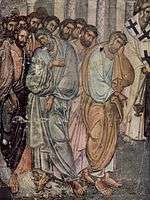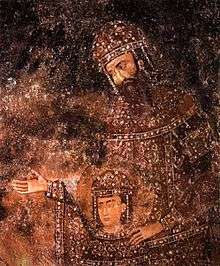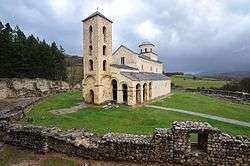Sopoćani
Coordinates: 43°7′5″N 20°22′26″E / 43.11806°N 20.37389°E
|
Overview of the Sopoćani | |
| Monastery information | |
|---|---|
| Full name | Сопоћани |
| Order | Serbian Orthodox |
| Established | 1259 - 1270 |
| Disestablished | 1689 |
| Reestablished | 1926 |
| Dedicated to | Holy Trinity |
| People | |
| Founder(s) | King Stefan Uroš I |
| Site | |
| Location | In Raška, Serbia, near the source of the Raška River in the region of Ras, the centre of the Serbian medieval state. |
| Public access | Yes |
| Official name | Stari Ras and Sopoćani |
| Type | Cultural |
| Criteria | i, iii |
| Designated | 1979 (3rd session) |
| Reference no. | 96 |
| Region | Europe and North America |
The Sopoćani monastery (Serbian Cyrillic: Сопоћани) (pronounced [sǒpotɕani]), an endowment of King Stefan Uroš I of Serbia, was built from 1259 to 1270, near the source of the Raška River in the region of Ras, the centre of the Serbian medieval state. It is a designated World Heritage Site, added in 1979 with Stari Ras.
History

In the 1160s, the Great Zupan Stefan Nemanja consolidated his power on the throne in Raska.[1] Although Nemanja's sons got the title of king and established the church as independent by making it autocephalous, developed the economic system and coined money, became richer and more sophisticated, the times, the work and person of Stefan Nemanja remained a great model and an example to be emulated by the younger generations. Sopoćani was an endowment of the Serbian King Stefan Uroš I, son to Stefan the First-Crowned and Nemanja's grandson. It was built in 1260 by King Uroš I Nemanjić as a church which would serve as his burial place, and was extended and renovated in the mid-14th century by his great-grandson Dušan. The church is dedicated to the Holy Trinity. Of the former larger monastery complex, which comprised numerous structures (dining rooms, residential buildings and others), today only the Church of the Holy Trinity remains. The monastery was once surrounded by a high stone wall with two gates. The completion of the painting of the main parts of the church can be indirectly dated to between 1263 and 1270. In Sopocani a decorative plan was carried out which was formed throughout the thirteenth century - in the chancel there are liturgical scenes, in the nave Christ's salvation work is shown through a cycle of the Great Feasts, in the narthex the Old Testament, dogmatic and eschatological themes are presented. Through the iconographic portraits of the Nemanjic family and through historical scenes Simeon Nemanja and Saint Sava. After Gradac (about 1275), the endowment of Queen Helen of Anjou, the wife of the founder of Sopocani - King Uros I - whose painters were high on the scale of creativity, there was a hiatus in creative artwork in Serbia. Archbishop Sava II, who became the head of the Serbian Orthodox Church in 1263, is represented in the procession of archbishops in the area of the altar. The frescoes of Sopoćani are considered by some experts on Serbian medieval art as the most beautiful of that period. On the western wall of the nave is a famous fresco of the Dormition of the Virgin. In the 16th century the monks had to temporarily leave the monastery on several occasions due to the Ottoman threat. Finally, during one of the raids in 1689 the Ottoman Turks set fire to the monastery and carried off the lead from the church roof. The brotherhood escaped with some important relics to Kosovo - but did not return to Sopoćani; it remained deserted for over two hundred years, until the 20th century. The church slowly decayed: its vaults caved in, its dome fell down, and the remains of the surrounding buildings were covered with rubble and earth.
Finally, during the 20th century the monastery was restored and today it is settled by a thriving brotherhood of dedicated monks. The fact that most of the Sopoćani frescoes still shine with radiant beauty - surviving more than two centuries of extreme exposure to the elements.
Sopoćani was declared Monument of Culture of Exceptional Importance in 1979, and it is protected by Republic of Serbia.
Gallery
 Monastery building.
Monastery building.- Detail of the fresco Dormition of the Mother of God from Sopoćani c. 1265
- Detail of the fresco Dormition of the Mother of God.
 Stefan Uroš I with his son Dragutin
Stefan Uroš I with his son Dragutin
Burials
In popular culture
Sopoćani, two episodes of the documentary series "Witnesses of Times" produced by the broadcasting service RTB in 1999-2000 was created by Petar Savkovića, directed by Stevan Stanić and Radoslav Moskovlović, music was composed by Zoran Hristić.[2][3]
See also
- Studenica
- Žiča
- Mileševa
- Visoki Dečani
- Gračanica
- Nemanjić dynasty
- Spatial Cultural-Historical Units of Great Importance
References
- ↑ By Their Fruit you will recognize them - Christianization of Serbia in Middle Ages, Perica Speher, 2010.
- ↑ Sopoćani - first episode on YouTube Official channel of RTS
- ↑ Sopoćani - second episode on YouTube Official channel of RTS
- Sopoćani, Vojislav Đurić, Prosveta, Beograd, 1991.
External links
| Wikimedia Commons has media related to Sopoćani. |
- Official website
- BLAGO Fund: Sopoćani
- Aerial video of the Sopoćani
- Sopoćani and Gradac - About the relation of funerary programmes of the two churches by Branislav Todić
- Representations of Lancet or Phlebotome in Serbian Medieval Art


